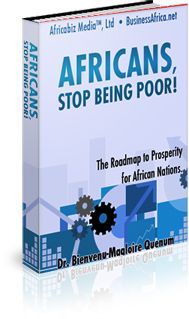|
****JavaScript based drop down DHTML menu generated by NavStudio. (OpenCube Inc. - http://www.opencube.com)****



|
| ! |
| AFRICABIZ
VOL 1 - ISSUE: 54
OCTOBER
15 - NOVEMBER 14, 2003
Previous
Issue
Editor: Dr. Bienvenu-Magloire
Quenum
Click here for contact & support console
| | A
WORD FROM THE EDITOR
| | |
|
Dear visitor and international investor,
We
warmly welcome you, if this is
your first visit to Africabiz
Online - The ultimate newsletter
on trading and investing in 49
sub-Saharan African countries.
If you are a regular and faithful
reader, welcome back.
-
INDUSTRIALIZATION IS THE RECIPE TO CREATING JOBS AND WEALTH
IN AFRICAN COUNTRIES
50 years after African countries recovered their sovereignty, Africa is still
in the backyard of economic development as shown by its meager share (1-2%) of
the international trade.
Africa is simply a marginal participant
in the global trade. Why is it so?
It is always good to ask the right
question in order to finding the adequate solution. Africa
is a small player in the jungle of international trade, because it has nothing
to offer apart from raw agricultural and mineral commodities - coffee, cocoa beans,
cotton, aluminum, manganese, iron, cobalt ores and diamonds.
To sell
on the international marketplace and garner profits, African countries have no
choice but to embrace the industrialization processing of their many agricultural
products and other commodities.
Currently, agricultural sector is the
main jobs' provider in sub-Saharan African countries (SSA) as shown in Table 1
below:
| TABLE
1
| |
Composition of Labor Force
and GNP's Evolution by World's Regions / 1980-2000 |
| Average
Annual % Growth | |
| Employment
Structure |
Gross National Product
| | |
Agriculture
| Industry
| Labor
Force | Total
| Agriculture
| Industry
| Services
| | High
Income | 7.5
| 33
| 1.05
| 2.6
| 2.45
| 1.95
| 2.85
| | Low
& Middle Income | 60.5
| 17.5
| 1.95
| 3.5
| 2.55
| 4.4
| 4.05
| | SSA
Countries | 70
| 9
| 2.75
| 2.0
| 2.5
| 1.35
| 2.45
| | East
Asia & Pacific | 72.5
| 14.5
| 1.8
| 8.95
| 4.35
| 11.95
| 8.7
| | South
Asia | 67
| 14.5
| 2.1
| 5.15
| 3.1
| 6.1
| 6.3
| | Europe
& Central Asia | 25
| 36.5
| 055
| -0.1
| 0.5
| 1.1
| 1.0
| | Middle
East & North Africa | 42
| 22.5
| 3.25
| 1.25
| 3.9
| 1.1
| 1.0
| | Latin
America & Caribbean | 29.5
| 24.5
| 2.65
| 2.45
| 2.15
| 1.95
| 2.85
| | World
| 51
| 20
| 1.8
| 2.05
| 2.05
| 2.35
| 3
| | Source:
Compiled From World Bank Development Reports Since 1980 |
However,
productivity and job's creation in African agricultural sector are not dynamic
enough to cope with jobs' demands generated by the increase of the population.
SSA countries do not either create jobs nor wealth on a sustained basis, which
is one the reasons of the prevailing poverty all over the continent.
Pr. Johannes Van
Biesebroeck, of Toronto's University, dedicated
an extensive study to the industrialization process in SSA countries. - Comparing
the Size and Productivity Distribution of Manufacturing Plants in sub-Saharan
Africa and the United States - published on April 2002. He found out that the
lagging industrialization process in sub-Saharan African countries contributes
to the low level of economic development in the region. Table 2 below is adapted
from Professor van Biesebroek's works:
| TABLE
2 |
| The
Share of Industry in The GNP of Sample Countries
|
| |
Aggregate Economy
| Employment
per Plant |
Coverage of GNP
| |
|
Population (millions)
|
PPP* US$ |
Share of Industry
|
Average |
Median
| | in
LF* | in
GNP | | Ethiopia
| 62.8
| 599
| 0.02
| 0.10
| 155
| 10
| 0.79
| | Burundi
| 6.7
| 533
| 0.03
| 0.16
| 61
| 12
| 0.65
| | Tanzania
| 32.9
| 478
| 0.05
| 0.17
| 91
| 12
| 0.31
| | Zambia
| 9.9
| 636
| 0.09
| 0.40
| 85
| 23
| 0.12
| | Kenya
| 30
| 975
| 0.07
| 0.17
| 95
| 22
| 0.17
| | Ivory
Coast | 14.7
| 630
| 0.08
| 0.16
| 168
| 18
| 0.48
| | Ghana
| 18.9
| 1,793
| 0.13
| 0.16
| 57
| 16
| 0.14
| | Zimbabwe
| 11.9
| 2.470
| 0.07
| 0.30
| 292
| 90
| 0.23
| | Cameroon
| 14.7
| 1,444
| 0.09
| 0.23
| 162
| 22
| 0.63
| | USA
| 273
| 30,600
| 0.17
| 0.19
| 61
| 9
| 1.00
|
| PPP*
= Parity Purchasing
Power. LF* = Labor Force. |
The comparison of the fourth and fifth columns reveals that the share of GNP generated
by the industrial sector is invariably higher than the share of the labor force
it employs. Value added per worker is higher in the industrial sector than in
agriculture or services - more than five times in some countries.
Expanding
the manufacturing sector - and its
interactivity with the agricultural one - and providing special training and
support to the farmers are sure recipes to boost up the economic activity in sub-Saharan
African countries - SSA. As shown by figures in column fifth - and contrary to
the common belief - industrial workers' productivity in some SSA countries perfectly
matches the productivity of their American colleagues.
The industrialization
process will create a larger
consumers' base in each African country with higher purchasing power. Therefore,
the dependence towards overseas markets would be less important in a first stage.
Otherwise, selling raw agricultural products - cotton, coffee, cacao beans to
name the few, will lead SSA countries to a dead end of continued poverty. Negotiation
rounds at the World Trade Organization will not give any reprieve to African farmers.
The solution is to process the agriculture products to satisfy national market
first and second African regional markets. Overseas markets coming as a last conquest.
Click following link for more about: After
Cancun, it is time to think about another strategy.
-
Contributor's Guidelines are here
to review. Your contribution on "How African countries / entrepreneurs
could bridge the developing gap" is welcome.
Many thanks for dropping by and see you here on November
15, 2003.
Dr. B.M. Quenum
Editor
of AFRICABIZ

| | | |
BUSINESS
OPPORTUNITIES IN AFRICA
| |
-
Several business opportunities - component parts of the Integrated Developing Scheme described in Africans, Stop Being Poor! are listed in following table.
| a-
SHEA BUTTER (Issues 5, 6,
7, 11,
12, 13)
b- BLUE GOLD (Issues 14,
15, 16,
17, 18,
19)
c- FREEZE-DRIED
PAPAIN (Issues 20, 21,
22 and here)
d- KENAF (Issues 23,
24)
e- VEGETABLE OIL
(Issues 25, 26,
27 and 28)
f- CEREALS (Issues 30,
31, 32,
33)
g- FRUITS
(34, 35,
36, 37,
38, 39,
40, 42,
43, 44,
45, 46)
h- ESSENTIAL OILS (47,
48, 49,
50, 51,
52) |
-
INTRODUCTION TO TROPICAL ROOTS AND TUBERS: I
- THE BURIED TREASURE OF DEVELOPING COUNTRIES
Historically, the cultivation of roots and tubers was performed to assure food
security for Africa's tribal kingdoms before the colonial era. Indeed, roots and
tubers are hidden wealth,
which are not destroyed by invaders during tribal warfare. In Africa, colonial
powers neglected their promotion and cultivation
- as international trading commodities - in favor of cash crops - coffee, cocoa,
cotton and tea. African farmers were left alone without any technical or marketing
support to provide roots and tubers to feed the population. For instance, in most
sub-Saharan African countries the increase of the production is done through extensive
method i.e. extension of plantation areas, instead of productivity's increase
through adequate fertilization, irrigation or variety improvement. More
on the matter is available here
-
ROOTS AND TUBERS ARE SURVIVAL CROPS
The major roots and tubers crops are: cassava, potato, sweet potato, and yam Click
here for a webpage dedicated to images and photos of roots and tubers. They
contribute to the energy and nutrition requirements of more than 2 billion
people in developing countries, and will continue to do so over the next
two decades as shown by the figure below, which compares the average annual
growth rate of most common staple foods up to 2020 - taking 1994-1996 period's
average production as reference.
| Average
Annual Growth Rate for Main Crops Up to 2020 - Data Source:
FAO |
 |
Cassava,
potato, and sweet potato rank among the top 10 food crops produced in developing
countries. Sub-Saharan Africa - SSA - is expected to experience the fastest
growth in food demand for all roots and tubers, largely driven by rapid population
growth. SSA share in the total demand for developing countries will be 53
percent, with cassava accounting for two-thirds of the increase.
-
ROOTS AND TUBERS ARE ECONOMIC CATALYSTS IGNORED BY SSA COUNTRIES
Roots
and tubers could be set up
as economic catalysts in an Integrated Scheme to boost up the development
of an African country. However, for the time being, roots and tubers produced
in sub-Saharan African countries (SSA) are consumed as food staple
- boiled (and crushed into pasta) and dried or wet flour. These foods are produced
by traditional methods by women who sell their production on villages and cities
markets.
Rare are the industrial concerns
established in SSA countries to transform these raw materials into value added
products - as reported in the diagram below. Contrary to what happened in Thailand,
where the country's policy-makers devised a winning strategy, to promote the
cultivation of cassava and related manufactured industrial products. Nowadays,
Thailand is a big player in the supply of cassava products for animal feed worldwide.
|
Diagram
About Cassava Transformation to Other Products |
| Sliced
Tubers | 
| Half
Finished
Animal Food |

| Dried
cossets; raspa (Brazil); glapeck (Thai) |

| |
| |
| | Cassava
Tubers | |
Food
Industry
| 
| Biscuit;
thickeners; binding
agent; constituent;
tapioca; glucose; sorbitol. Etc.
| 
| |

| |
| | Press
| 
| Starch
| |
| 
| |

| |
| Humidified
Products | 
| Dried
Products | 
| Gari;
farinha;
foufou; attiéké. |
| | |

| |
| | |
| Industrial
Utilization
| 
| Paper;
bio-plastics;
textiles; fermentation
composites; drilling. Etc.
| In
next issue 55 several opportunities available to using roots and tubers as
an economic catalyst will be explored.
Adobe
Acrobat Reader is available here
- Interested parties - private African and international investors /
companies, government
agencies,
international development
agencies - to make contact through the Free Access Support Console available at this link
Contact through the support console will get quickest reply from Africabiz Online's staff, than contact by emails. Click here for contact information. Be advised that first contact should be through the support console to be followed by phone calls. If you are a VIP-Member, use VIP-Members Support Console available here.
Before you consult please click
here to review this clarification
| |

